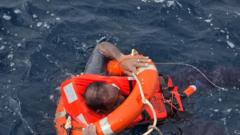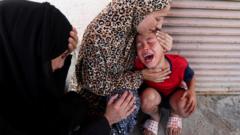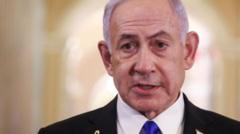Autopsy results confirm that the majority of paramedics killed in a March attack in Gaza were shot in critical areas, leading to widespread calls for accountability from both humanitarian organizations and international observers.
Autopsies Reveal Fatal Assault on Gaza Medics by Israeli Forces

Autopsies Reveal Fatal Assault on Gaza Medics by Israeli Forces
Reports indicate that medics killed in Gaza attack suffered lethal head and chest injuries, raising concerns over potential war crimes.
In a recent analysis of the tragic events surrounding the March 23 attack in Gaza, autopsy findings implicate Israeli forces in a lethal assault on emergency medical workers. Reports from The New York Times indicate that the victims, 14 rescue workers and one UN employee, suffered primarily from gunshot wounds to the head and chest, along with additional shrapnel injuries. This assault, recognized by Israel, involved clear targeting of ambulances and fire trucks operated by the Palestine Red Crescent Society and Civil Defense.
Eyewitness accounts and corroborative audio-visual evidence documented the chaos of that day, leading to an indictment of actions viewed by many as disproportionate and reckless. The Israeli military’s shifting rationale for the assault — claiming that some deceased were affiliated with Hamas — has been met with skepticism and has not been substantiated with evidence, raising serious concerns about potential violations of international humanitarian law.
IDF forces reportedly conducted the attack on the emergency vehicles, which ended in the deaths of 15 individuals, sparking widespread global condemnation. The bodies of the deceased were initially buried in a mass grave, with military forces subsequently crushing the ambulances and fire truck. An investigation has been promised by Israel regarding the incident, a move many consider insufficient given the nature of the tragedy.
The autopsy procedures conducted from April 1 to April 5 were led by Dr. Ahmad Dhair, head of the Gaza health ministry's forensic unit, and were scrutinized by Dr. Arne Stray-Pedersen, a Norwegian forensic pathologist familiar with the region. This collaboration aimed to document the irrefutable impact of this assault on humanitarian workers and highlight the ongoing risks they face in conflict zones.
In light of these findings, international humanitarian organizations have reiterated calls for accountability and transparency from Israeli authorities and relentlessly advocated for the protection of medical personnel operating in conflict situations. As this situation unfolds, the horrific implications for the already fraught dynamics of the region continue to intensify.
Eyewitness accounts and corroborative audio-visual evidence documented the chaos of that day, leading to an indictment of actions viewed by many as disproportionate and reckless. The Israeli military’s shifting rationale for the assault — claiming that some deceased were affiliated with Hamas — has been met with skepticism and has not been substantiated with evidence, raising serious concerns about potential violations of international humanitarian law.
IDF forces reportedly conducted the attack on the emergency vehicles, which ended in the deaths of 15 individuals, sparking widespread global condemnation. The bodies of the deceased were initially buried in a mass grave, with military forces subsequently crushing the ambulances and fire truck. An investigation has been promised by Israel regarding the incident, a move many consider insufficient given the nature of the tragedy.
The autopsy procedures conducted from April 1 to April 5 were led by Dr. Ahmad Dhair, head of the Gaza health ministry's forensic unit, and were scrutinized by Dr. Arne Stray-Pedersen, a Norwegian forensic pathologist familiar with the region. This collaboration aimed to document the irrefutable impact of this assault on humanitarian workers and highlight the ongoing risks they face in conflict zones.
In light of these findings, international humanitarian organizations have reiterated calls for accountability and transparency from Israeli authorities and relentlessly advocated for the protection of medical personnel operating in conflict situations. As this situation unfolds, the horrific implications for the already fraught dynamics of the region continue to intensify.




















